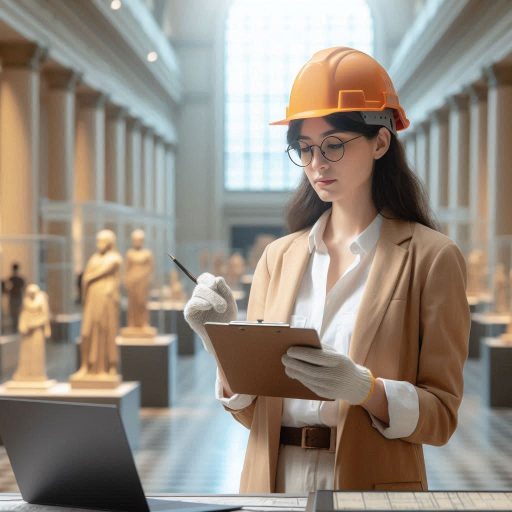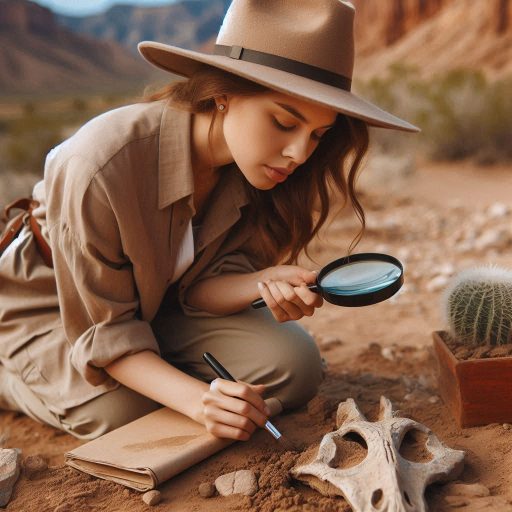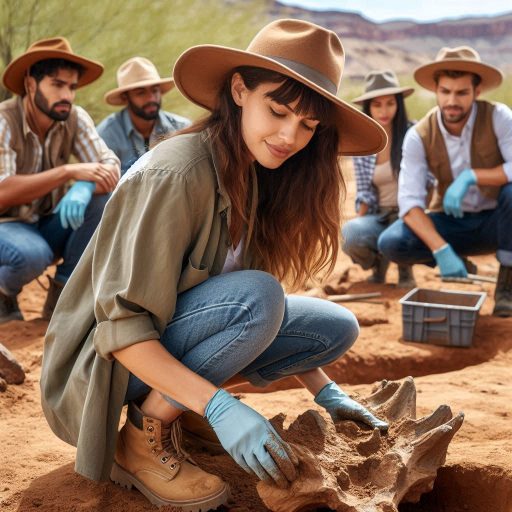Introduction
Archaeological research is the study of past human societies through material remains.
This field examines artifacts, structures, and landscapes to uncover historical narratives.
Archaeologists excavate sites and analyze findings to gain insights into ancient cultures.
Understanding archaeology is essential for studying history.
It provides tangible evidence of how people lived, interacted, and evolved.
Through artifacts, we learn about daily life, social structures, and economic practices in different eras.
Archaeological research reveals the complexities of human behavior and adaptation over time.
It helps us connect with our ancestors and understand their contributions to modern society.
By preserving artifacts, we maintain a record of our shared heritage.
Furthermore, archaeological discoveries often challenge established historical narratives.
New findings can reshape our understanding of significant events and cultural exchanges.
This research fosters critical thinking about the past and encourages deeper engagement with history.
Archaeological research is vital for uncovering the stories of human civilization.
It enriches our knowledge of history and preserves cultural heritage for future generations.
By studying the past, we gain a more profound appreciation for the complexities of human life.
Preservation of artifacts
Archaeological research plays a vital role in preserving artifacts for future generations.
Artifacts serve as physical evidence of past human behavior and culture.
They provide insights into the daily lives, beliefs, and practices of ancient societies.
Preserving these artifacts allows us to connect with our shared history.
How Archaeological Research Helps in Preserving Artifacts
Archaeologists use various methods to preserve artifacts during excavation.
They carefully document each find, recording its location and context.
This meticulous approach ensures that artifacts retain their historical significance.
Proper conservation techniques also protect artifacts from deterioration and damage.
These techniques include cleaning, stabilization, and climate-controlled storage.
Significance of Artifacts in Understanding History
The significance of artifacts in understanding history cannot be overstated.
They act as tangible links to our past, revealing information about ancient civilizations.
For example, pottery can provide insights into trade, technology, and dietary practices.
Similarly, tools offer clues about the skills and capabilities of early humans.
Each artifact contributes to a broader understanding of human development and cultural evolution.
Examples of Important Artifacts Discovered Through Archaeological Research
One important artifact discovered through archaeological research is the Rosetta Stone.
Found in Egypt in 1799, this stone features inscriptions in three scripts.
It enabled scholars to decipher Egyptian hieroglyphs, unlocking the secrets of ancient Egyptian civilization.
The Rosetta Stone illustrates how a single artifact can transform our understanding of history.
Another notable example is the Terracotta Army.
Discovered in China in 1974, this massive collection of life-sized sculptures represents the army of Qin Shi Huang.
The Terracotta Army provides insight into the military practices and beliefs of ancient China.
This archaeological find showcases the artistry and craftsmanship of the time.
Additionally, the discovery of ‘tzi the Iceman in the Alps has revolutionized our understanding of prehistoric life.
This naturally mummified body dates back over 5,000 years.
Analysis of ‘tzi‘s clothing, tools, and diet has revealed valuable information about Copper Age Europeans.
Such discoveries highlight the critical role of archaeological research in preserving our understanding of history.
The preservation of artifacts is essential for understanding our past.
Archaeological research ensures that these objects remain intact and accessible for future generations.
By studying artifacts, we gain invaluable insights into the lives of our ancestors.
Each artifact tells a story, contributing to the rich tapestry of human history.
Thus, supporting archaeological research is crucial for preserving our collective heritage.
Read: Preparing for a Botany PhD: Tips and Advice
Reconstruction of past societies
Archaeologists utilize artifacts to reconstruct past societies and understand their complexities.
They analyze items such as tools, pottery, and structures to gain insights.
Each artifact serves as a puzzle piece, helping to build a more complete picture of ancient life.
Using Artifacts to Reconstruct Past Societies
Artifacts reveal essential information about the daily lives of past peoples.
For example, pottery styles indicate trade relationships and cultural exchanges.
Archaeologists study the shapes, decorations, and materials used in pottery to determine their origins.
These details help trace the interactions between different groups.
Tools also provide insights into the technological capabilities of ancient societies.
By examining the wear patterns on stone tools, archaeologists can infer their uses.
This analysis reveals information about subsistence strategies, hunting practices, and craftsmanship.
In this way, artifacts form the foundation of our understanding of ancient societies.
Understanding Culture, Lifestyle, and Practices
Reconstructing past societies helps us understand their culture, lifestyle, and practices.
For instance, the layout of ancient settlements offers insights into social organization.
By studying the spatial arrangement of homes, communal spaces, and fortifications, archaeologists can infer social hierarchies and community interactions.
Artifacts related to rituals and religious practices provide further context.
Items such as altars, figurines, and ceremonial tools reveal beliefs and values.
Understanding these cultural aspects enhances our knowledge of how societies functioned and thrived.
Successful Reconstructions Based on Archaeological Findings
One successful reconstruction is the ancient city of Pompeii.
The eruption of Mount Vesuvius in 79 AD preserved this Roman city under volcanic ash.
Archaeologists have uncovered streets, buildings, and everyday items, allowing us to visualize life in ancient Rome.
The findings provide a vivid snapshot of Roman urban life, including social structures and daily activities.
Another example is the reconstruction of the Viking settlement at L’Anse aux Meadows in Newfoundland, Canada.
Archaeologists excavated remains of buildings and artifacts from the Norse exploration of North America.
These discoveries demonstrate Viking maritime skills and their interactions with Indigenous peoples.
This reconstruction challenges previous assumptions about Viking exploration.
In Mesoamerica, the study of the Maya civilization illustrates how artifacts inform our understanding of past societies.
Excavations at sites like Tikal reveal complex urban planning and monumental architecture.
Artifacts such as stelae and pottery tell stories of political power and religious practices.
These findings contribute to a broader understanding of Maya society and its achievements.
Archaeologists reconstruct past societies through the careful study of artifacts.
This process helps us understand the culture, lifestyle, and practices of ancient civilizations.
Successful reconstructions, like those of Pompeii, L’Anse aux Meadows, and the Maya, demonstrate the significance of archaeological research.
By examining the remnants of the past, we gain valuable insights into the human experience and the development of societies over time.
Read: Interdisciplinary Research: Botany and Other Sciences
Uncovering historical mysteries
How archaeological research helps in solving historical mysteries
Archaeological research plays a crucial role in solving historical mysteries.
It uncovers artifacts, structures, and other evidence that shed light on past events.
Through careful excavation and analysis, archaeologists piece together fragments of history that illuminate our understanding of the past.
Famous Cases of Archaeological Discoveries
One famous case is the discovery of King Tutankhamun’s tomb in 1922.
This tomb, located in Egypt’s Valley of the Kings, contained a wealth of artifacts.
The treasures found inside revealed insights into ancient Egyptian burial practices and beliefs about the afterlife.
This discovery sparked global interest in ancient Egypt and increased our understanding of its culture.
Another significant archaeological finding involves the ruins of the city of Pompeii.
The eruption of Mount Vesuvius in 79 AD preserved this Roman city under layers of ash.
Excavations have revealed well-preserved buildings, artwork, and everyday items.
These findings provide a snapshot of Roman life, commerce, and social structures, helping historians piece together the events surrounding the eruption.
The excavation of the ancient city of Troy is another notable example.
Initially considered a myth, archaeological work by Heinrich Schliemann in the 19th century uncovered layers of settlement.
These discoveries validated the historical basis for the Trojan War, described in Homer’s epic poems.
The evidence from Troy illustrates the intersection of myth and history.
The Role of Archaeologists in Piecing Together History
Archaeologists serve as detectives, analyzing artifacts and structures to reconstruct past events.
They examine material culture, such as pottery styles and tool types, to understand social dynamics.
This process involves extensive research and collaboration with historians, anthropologists, and other experts.
For example, the study of the Mayan civilization has helped clarify its mysterious decline.
Archaeological research at sites like Tikal and Cop‘n has revealed clues about environmental factors, warfare, and social changes.
By examining the evidence, researchers have developed theories about the reasons for the civilization’s collapse.
Archaeological research also sheds light on historical events, such as the Viking exploration of North America.
Excavations at L’Anse aux Meadows provided concrete evidence of Norse presence in North America.
This finding confirmed the sagas and stories of Viking voyages, enriching our understanding of their maritime history.
The investigation of shipwrecks offers another avenue for uncovering historical mysteries.
The discovery of the Titanic in 1985 revealed details about the ship’s construction and the tragedy’s events.
Artifacts recovered from the site provide insights into early 20th-century maritime practices and social class distinctions.
Aarchaeological research helps solve historical mysteries by uncovering artifacts and evidence from the past.
Famous discoveries, such as those at King Tutankhamun’s tomb, Pompeii, and Troy, illustrate the power of archaeology in understanding history.
Archaeologists play a vital role in piecing together fragmented narratives, shedding light on significant historical events.
Through their efforts, we gain a deeper appreciation for the complexities of human history and the stories that shaped our world.
Read: Women in Botany: Celebrating Pioneers and Leaders

Correcting historical inaccuracies
How archaeological research helps in correcting historical inaccuracies
Archaeological research plays a critical role in correcting historical inaccuracies.
It uncovers evidence that challenges accepted narratives and provides a more accurate picture of the past.
By integrating archaeological findings into historical studies, researchers can rectify misunderstandings and misinterpretations that have persisted for centuries.
Instances of Challenging Traditional Historical Narratives
One prominent example involves the ancient city of Troy.
For many years, historians considered Troy a mere myth.
However, Heinrich Schliemann’s excavations in the 19th century revealed layers of destruction, suggesting a real conflict occurred.
This finding validated elements of the Trojan War, as described in Homer’s epics, showcasing how archaeology can confirm or refute historical narratives.
Another example is the discovery of Viking settlements in North America.
Traditional history credited Columbus with the “discovery” of America in 1492.
However, archaeological findings at sites like L’Anse aux Meadows in Newfoundland demonstrated that Vikings reached North America around 1000 AD.
These discoveries shifted our understanding of early trans-oceanic contact and the Norse influence on indigenous cultures.
Archaeology has also provided insights into the history of ancient Egypt.
The interpretation of hieroglyphs and inscriptions has evolved over time.
For instance, the belief that all Pharaohs were male has been challenged by the discovery of female rulers like Hatshepsut.
This has led historians to reevaluate gender roles in ancient Egyptian society, illustrating the importance of accurate archaeological evidence.
Importance of Incorporating Archaeological Evidence
Incorporating archaeological evidence in historical studies enhances our understanding of past societies.
It offers a tangible connection to the experiences of people long gone.
Artifacts, structures, and ecofacts provide context for historical events, enriching the narrative beyond written records.
For instance, the excavation of the ancient city of Pompeii has revealed details about daily life in Roman society.
The preservation of buildings, graffiti, and household items offers insight into social dynamics, economic activities, and cultural practices.
This information complements literary sources and helps create a more comprehensive view of Roman life.
Archaeology also corrects inaccuracies regarding indigenous populations in the Americas.
Traditional narratives often marginalized these cultures.
However, archaeological research at sites like Cahokia has demonstrated the complexity and sophistication of pre-Columbian societies.
This challenges the notion that indigenous peoples were primitive or lacking in development.
Furthermore, the study of human remains can reveal information about health, diet, and social structures.
For example, bioarchaeological studies of skeletal remains can indicate dietary changes resulting from colonization.
Such findings help historians understand the broader impact of historical events on populations.
Archaeological research is vital for correcting historical inaccuracies.
Instances such as the validation of the Trojan War and Viking discoveries illustrate this role.
Incorporating archaeological evidence into historical studies provides a more nuanced understanding of the past.
By doing so, we can develop a more accurate and inclusive narrative of human history, acknowledging the complexities and richness of diverse cultures.
Read: How Climate Change Is Impacting Plant Research
Delve into the Subject: Preparing for an Epidemiology Job Interview
Transform Your Career Today
Unlock a personalized career strategy that drives real results. Get tailored advice and a roadmap designed just for you.
Start NowCultural heritage preservation
Role of archaeology in preserving cultural heritag
Archaeology plays a vital role in preserving cultural heritage.
It helps protect our shared history and informs future generations about past societies.
Through careful excavation and documentation, archaeologists ensure that artifacts and sites are preserved for posterity.
This preservation is essential for understanding the development of human civilization.
Protecting Archaeological Sites
The importance of protecting archaeological sites cannot be overstated.
Looting and destruction pose significant threats to these invaluable resources.
Criminal activities often result in the irreversible loss of historical evidence.
Archaeologists advocate for stronger laws and regulations to safeguard sites from such threats.
They work with governments and organizations to create protected areas.
By raising awareness about the significance of these sites, archaeologists help foster a culture of preservation.
Community engagement is crucial for protecting archaeological heritage.
Local communities often hold the key to preserving their cultural heritage.
By involving them in archaeological projects, researchers can promote stewardship of sites.
Education programs can teach locals about the historical value of their heritage.
This approach encourages communities to take pride in their history and actively participate in preservation efforts.
Impact on Cultural Tourism and Education
Archaeological research also significantly impacts cultural tourism and education.
Well-preserved sites attract tourists, generating economic benefits for local communities.
These visitors contribute to the economy while gaining insights into ancient cultures.
Archaeology transforms historical sites into educational resources, providing immersive learning experiences.
Visitors can connect with the past through guided tours, exhibitions, and interactive programs.
Moreover, cultural tourism encourages the conservation of archaeological sites.
As communities recognize the economic benefits, they become more invested in protecting their heritage.
Increased awareness of historical significance often leads to stronger preservation initiatives.
Archaeological sites can serve as catalysts for community development, fostering pride in local culture.
Educational programs offered at archaeological sites enhance understanding and appreciation of cultural heritage.
Schools can organize field trips to engage students with real-world history.
Such experiences ignite curiosity and foster a deeper connection to the past.
By educating the public about archaeology, researchers inspire future generations to value their heritage.
Archaeology plays a crucial role in preserving cultural heritage.
It protects archaeological sites from looting and destruction, ensuring their survival.
The involvement of local communities enhances preservation efforts, fostering pride and stewardship.
Archaeological research also impacts cultural tourism and education, generating economic benefits and enriching public understanding.
By safeguarding our cultural heritage, archaeology helps connect people with their past, promoting a sense of identity and continuity.
Collaboration with other disciplines
How archaeology collaborates with other disciplines like anthropology, history, and geology
Archaeology thrives through collaboration with various disciplines.
Working alongside anthropology, history, and geology enriches archaeological research.
Each discipline brings unique perspectives and techniques that enhance our understanding of past societies.
Interdisciplinary Research Benefits
Collaboration between disciplines offers several benefits.
It helps create a more comprehensive understanding of historical contexts.
For instance, anthropologists provide insights into cultural practices and social structures.
This knowledge can inform archaeological interpretations of artifacts and sites.
Historians contribute their expertise in documenting events, which complements archaeological findings.
By analyzing texts and historical records, they help establish timelines and contexts.
Geology plays a critical role in archaeological research.
Geologists analyze soil and sediment samples, providing information about past environments.
Their expertise helps archaeologists understand how landscapes changed over time.
This knowledge is crucial for interpreting the location and significance of archaeological sites.
The interdisciplinary approach allows researchers to build a more nuanced understanding of ancient human behavior.
Successful Collaborations
Several successful collaborations exemplify the benefits of interdisciplinary research.
One notable example is the study of the ancient city of ‘atalh‘y‘k in Turkey.
Archaeologists, anthropologists, and geologists worked together to uncover the site’s complexities.
This collaboration revealed insights into the community’s social structure, diet, and environment.
Researchers used geological data to understand the site’s settlement patterns and environmental changes.
Another successful collaboration occurred at the Maya site of Cop‘n in Honduras.
Archaeologists partnered with botanists and ecologists to study ancient agricultural practices.
By analyzing plant remains and soil samples, they reconstructed ancient farming methods.
This research provided valuable insights into the Maya’s relationship with their environment.
Additionally, the study of prehistoric cave paintings in Europe showcases interdisciplinary collaboration.
Archaeologists collaborated with chemists to analyze pigment compositions.
This analysis revealed information about the materials used and their origins.
Understanding these pigments helps researchers contextualize the artworks within their cultural and historical settings.
Collaboration with other disciplines significantly enhances archaeological research.
By integrating knowledge from anthropology, history, and geology, researchers gain a more comprehensive understanding of the past.
Successful collaborations demonstrate the value of interdisciplinary approaches in archaeology.
These partnerships help reconstruct ancient societies, unravel historical mysteries, and provide insights into human behavior.
As archaeology continues to evolve, interdisciplinary collaboration will remain vital in uncovering the complexities of our shared history.
Gain More Insights: Botany and Biotechnology: Merging Fields of Science
Conclusion
Archaeological research plays a crucial role in studying history.
It helps us understand past societies and their cultures.
By preserving artifacts, we gain valuable insights into historical narratives.
Reconstructing past societies allows us to appreciate ancient lifestyles and practices.
Archaeology also aids in solving historical mysteries.
It uncovers lost knowledge and corrects historical inaccuracies.
Through rigorous research, archaeologists challenge established narratives and provide new perspectives.
Additionally, archaeology preserves cultural heritage for future generations.
Protecting archaeological sites from destruction ensures that we honor our shared history.
Collaboration with other disciplines enriches archaeological research, providing a broader understanding of the past.
These elements highlight the importance of supporting archaeological research.
Promoting archaeological initiatives enhances our collective knowledge and appreciation of history.
By investing in this field, we foster deeper connections to our cultural heritage.
Ultimately, we encourage everyone to engage with archaeology.
Visit museums, attend lectures, and participate in local excavations.
Supporting archaeological research not only enriches our understanding of history but also preserves our shared cultural identity.
Together, we can ensure that the stories of our past continue to inform and inspire future generations.
[E-Books for Sale]
The Big Book of 500 High-Paying Jobs in America: Unlock Your Earning Potential
$19.99 • 500 High-Paying Jobs • 330 pages
Explore 500 high-paying jobs in America and learn how to boost your career, earn more, and achieve success!
See All 500 High-Paying Jobs of this E-Book
1001 Professions Without a Degree: High-Paying American Jobs You Can Start Now
$19.99 • 1001 Professions Without a Degree • 174 pages
Discover 1001 high-paying jobs without a degree! Unlock career tips, skills, and success strategies for just $19.99!




